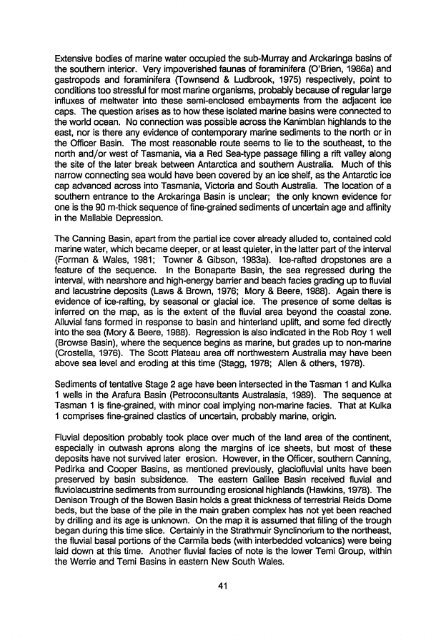II II II II II - Geoscience Australia
II II II II II - Geoscience Australia
II II II II II - Geoscience Australia
Create successful ePaper yourself
Turn your PDF publications into a flip-book with our unique Google optimized e-Paper software.
Extensive bodies of marine water occupied the sub-Murray and Arckaringa basins of<br />
the southern interior. Very impoverished faunas of foraminifera (O'Brien, 1986a) and<br />
gastropods and foraminifera (Townsend & Ludbrook, 1975) respectively, point to<br />
conditions too stressful for most marine organisms, probably because of regular large<br />
influxes of meltwater into these semi-enclosed embayments from the adjacent ice<br />
caps. The question arises as to how these isolated marine basins were connected to<br />
the world ocean. No connection was possible across the Kanimblan highlands to the<br />
east, nor is there any evidence of contemporary marine sediments to the north or in<br />
the Officer Basin. The most reasonable route seems to lie to the southeast, to the<br />
north and/or west of Tasmania, via a Red Sea-type passage filling a rift valley along<br />
the site of the later break between Antarctica and southern <strong>Australia</strong>. Much of this<br />
narrow connecting sea would have been covered by an ice shelf, as the Antarctic ice<br />
cap advanced across into Tasmania, Victoria and South <strong>Australia</strong>. The location of a<br />
southern entrance to the Arckaringa Basin is unclear; the only known evidence for<br />
one is the 90 m-thick sequence of fine-grained sediments of uncertain age and affinity<br />
in the Mallabie Depression.<br />
The Canning Basin, apart from the partial ice cover already alluded to, contained cold<br />
marine water, which became deeper, or at least quieter, in the latter part of the interval<br />
(Forman & Wales, 1981; Towner & Gibson, 1983a). Ice-rafted dropstones are a<br />
feature of the sequence. In the Bonaparte Basin, the sea regressed during the<br />
interval, with nearshore and high-energy barrier and beach facies grading up to fluvial<br />
and lacustrine deposits (Laws & Brown, 1976; Mory & Beere, 1988). Again there is<br />
evidence of ice-rafting, by seasonal or glacial ice. The presence of some deltas is<br />
inferred on the map, as is the extent of the fluvial area beyond the coastal zone.<br />
Alluvial fans formed in response to basin and hinterland uplift, and some fed directly<br />
into the sea (Mory & Beere, 1988). Regression is also indicated in the Rob Roy 1 well<br />
(Browse Basin), where the sequence begins as marine, but grades up to non-marine<br />
(Crostella, 1976). The Scott Plateau area off northwestern <strong>Australia</strong> may have been<br />
above sea level and eroding at this time (Stagg, 1978; Allen & others, 1978).<br />
Sediments of tentative Stage 2 age have been intersected in the Tasman 1 and Kulka<br />
1 wells in the Arafura Basin (Petroconsultants Australasia, 1989). The sequence at<br />
Tasman 1 is fine-grained, with minor coal implying non-marine facies. That at Kulka<br />
1 comprises fine-grained clastics of uncertain, probably marine, origin.<br />
Fluvial deposition probably took place over much of the land area of the continent,<br />
especially in outwash aprons along the margins of ice sheets, but most of these<br />
deposits have not survived later erosion. However, in the Officer, southern Canning,<br />
Pedirka and Cooper Basins, as mentioned previously, glaciofluvial units have been<br />
preserved by basin subsidence. The eastern Galilee Basin received fluvial and<br />
fluviolacustrine sediments from surrounding erosional highlands (Hawkins, 1978). The<br />
Denison Trough of the Bowen Basin holds a great thickness of terrestrial Reids Dome<br />
beds, but the base of the pile in the main graben complex has not yet been reached<br />
by drilling and its age is unknown. On the map it is assumed that filling of the trough<br />
began during this time slice. Certainly in the Strathmuir Synclinoriunn to the northeast,<br />
the fluvial basal portions of the Carmila beds (with interbedded volcanics) were being<br />
laid down at this time. Another fluvial facies of note is the lower Temi Group, within<br />
the Werrie and Temi Basins in eastern New South Wales.<br />
41

















